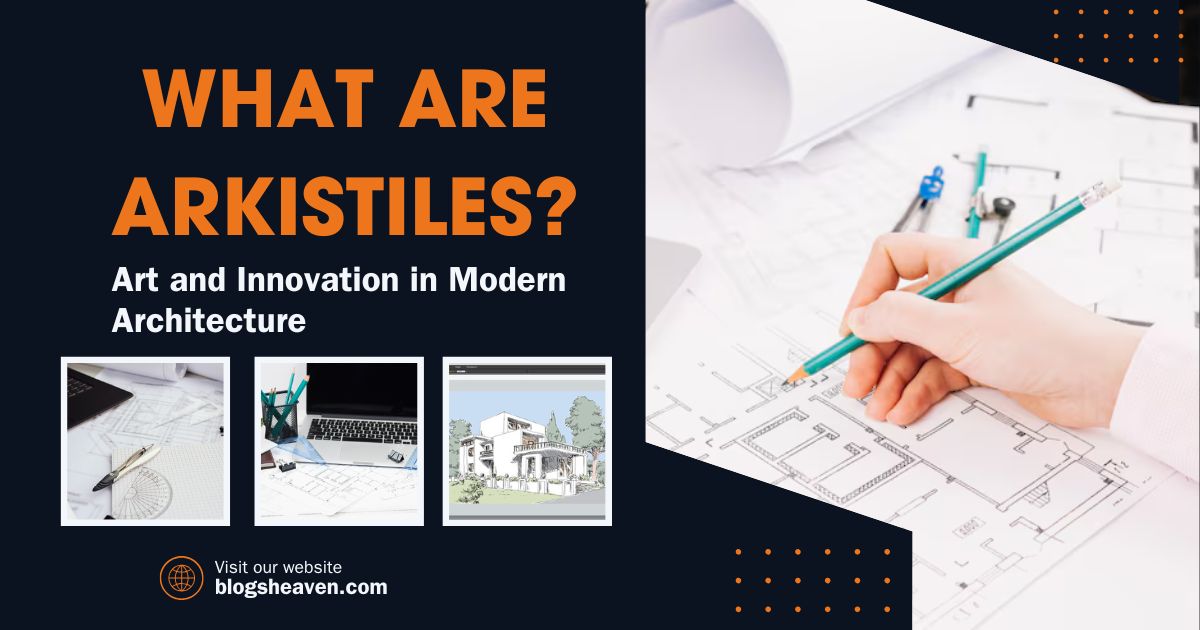Architecture has always been both an art form and a science, with new ideas coming forth at different times to meet the needs of those times. The word “Arkistiles” has just surfaced as a fresh way of describing buildings in the modern era. But what are Arkistiles, and why are they becoming popular among designers? Learn more about Arkistiles—what they were for, how to identify them, and how they shaped contemporary architecture—in this in-depth study. We will also talk about why Arkistiles are popular among architects and enthusiasts right now, and how they are changing the way design is done.
What Are Arkistiles?
Arkistiles are a type of contemporary building that combines aesthetics and functionality. Using this method, architects may make buildings that look good without compromising on functionality or longevity. The “Arkistiles” school of thought draws from the fields of art and architecture, and its guiding principles emphasize the need of designing environments that encourage creativity and new ideas.
Arkistiles place an emphasis on adaptability and uniqueness, in contrast to conventional architectural styles. This flexibility enables designers to create unique rooms that meet individual wants and tastes, leading to personalized settings that deviate from conventional design principles.
The Origins of Arkistiles in Architecture
The original inspiration for arkistiles came from a desire to revolutionize architecture. Architects started to challenge the inflexible structures of previous designs as the fads changed. Arkistiles were created as a solution to address modern demands while embracing open-ended innovation.
The minimalist movements of the twentieth century, in which form and function were considered equally important, were an early inspiration for Arkistiles. Arkistiles, on the other hand, drew inspiration from a wide range of disciplines, including digital technology, interior design, landscape architecture, and others, as the discipline of architecture became increasingly multidisciplinary.
Key Principles of Arkistiles
Five guiding principles—originality, adaptability, sustainability, practicality, and customization—form the basis of its. The distinctiveness of Arkistiles as a philosophy of design is enhanced by each principle:
Creativity
Prompts architects to test the boundaries of traditional architecture by investigating unconventional shapes and styles..
Flexibility
Structures may change and adapt to meet the demands of their users as they change.
Sustainability
Green procedures and materials are given top priority.
Functionality
Creates a harmonious blend of aesthetics and functionality.
Personalization
Creates unique designs by reflecting personal taste and function.
Following these guidelines, it rethought building architecture to meet the needs of contemporary society.
The Role of Technology in Shaping Arkistiles
In Arkistiles, technology is vital because it lets architects try out complicated concepts that were previously unattainable. Technological developments, such as computer-aided design (CAD) and 3D printing, give the resources for the innovative and precise construction of buildings.
With the use of VR and AR, architects can now try out their designs in fully immersive settings before committing to a final version. In addition to facilitating the detection of any problems, these technologies also assist in conveying ideas to customers in a way that is consistent with their vision.
How Arkistiles Promote Sustainable Design
Their commitment to environmental responsibility is one of it’s most alluring features. Both the building’s inhabitants and the environment may reap the benefits of this concept’s emphasis on energy efficiency and the use of environmentally friendly materials. Sustainable living is becoming increasingly popular, and Arkistiles caters to that need with features like solar panels, green roofs, and recycled materials.
Arkistiles’ popularity has been boosted by the growing trend of eco-friendly building designs. Buildings may have less of an impact on the environment without sacrificing style or functionality when architects use sustainable techniques and energy-saving technology.
Functional Aesthetics: Balancing Beauty and Practicality
The capacity to balance form and function is a hallmark of Arkistiles. The aesthetic value and functional needs of each place are balanced out in this way. The Arkistiles stress that form and function should not be separated in any way, but should instead exist in perfect harmony.
Natural materials, open floor plans, and plenty of natural light bring character and warmth to a room while still meeting functional requirements. They are well-liked in both commercial and residential design because to their balanced approach.
Arkistiles and Interior Design
Arkistiles are a great way to create dynamic, multi-purpose rooms in interior design. Architects prioritize versatility when designing interiors, enabling spaces to be modified according to evolving needs. The area can accommodate different activities without sacrificing design, thanks to features like adjustable lighting and flexible furniture.
The minimalist style, with its emphasis on clean lines and uncomplicated arrangements, is also common in Arkistiles’ interior design. In addition to improving the space’s visual appeal, this method also produces a feeling of tranquility and structure.
Embracing Natural Elements in Arkistiles
The Arkistiles method relies heavily on organic materials like wood, stone, and glass, and places a premium on natural aspects. Incorporating these features into a structure strengthens its bond to its environment and gives internal areas a more natural feel.
Another important aspect of Arkistiles is the use of natural light. To improve energy efficiency and lessen the need for artificial lighting, large windows, skylights, and open floor plans make the most of natural sunshine. Living in harmony with nature not only makes for a more peaceful environment, but it also inspires people to live greener lives.
The Impact of Arkistiles on Urban Development
Especially in towns that value parks and pedestrian-friendly streets, arkistiles affect city planning in a big way. One way architects may help build better communities is by making buildings that blend in with their surroundings.
Green walls, rooftop gardens, and other environmentally friendly elements are common in Arkistiles-inspired structures, which help to make cities healthier and more habitable. These components support eco-friendly living by attending to people’s and the planet’s basic need in city development.
Customization in Arkistiles: Personalizing Space
Arkistiles’ fundamental feature of personalization lets architects modify any building to suit the requirements of its occupants. When individuals use this approach, their environments become more a reflection of who they are and how they live.
They build environments that are more than just utilitarian through their material choices, room layouts, and distinctive design aspects. People who want their homes or offices to reflect who they are will appreciate this degree of personalization.
The Benefits of Arkistiles in Residential Design
Arkistiles provide several advantages for home improvement projects. Ideal for families or individuals seeking adaptable homes, they focus comfort, beauty, and utility.
Energy efficiency, versatile areas, and a harmonious integration with nature are some of the main benefits. They are a great option for homeowners who are concerned about the environment and appreciate a combination of form and function in their homes.
Challenges and Considerations in Adopting
The benefits of it aren’t without their drawbacks, though; the biggest ones are related to money and knowledge. Some of the technologies and materials utilized in these designs can make them more costly than more conventional approaches. The complexity of it is something not many builders are familiar with, which may add time and money to a project.
In order to make sure the design stays true to the original idea, Arkistiles enthusiasts must collaborate with builders and architects who are well-versed in the method.
The Future in Architecture
They are expected to take center stage as architectural trends progress. They are well-suited for future advances since their focus on sustainability, personalization, and usefulness meshes with the demands of current society.
The potential applications of Arkistiles are boundless as long as technology and materials continue to progress. This architectural style will keep inspiring new concepts and advancements in the industry as consumers desire more sustainable and individualized places.
Why They Are a Game-Changer for the Architecture Industry
The way humans perceive structures and environments is evolving because to arkistiles. Their comprehensive approach to design, which blends creativity with pragmatism, speaks to modern ideals. It meet a wide variety of demands, from eco-friendly methods to customized design, mirroring the hopes for a more aware and interconnected society.
Conclusion
What Are Arkistiles? They represent contemporary life and are more than simply a passing fad in architecture. Spaces are being transformed into individualized places that fulfill current demands through this style’s emphasis on sustainability, innovation, and utility. They are a great way for architects and homeowners to make eco-friendly, versatile environments that are also aesthetically pleasing. It will keep transforming the world of architecture by inspiring new possibilities as this movement evolves, improving the environments we live in.
FAQs
What is the primary focus of Arkistiles?
It prioritize a balance between aesthetics, functionality, and sustainability, making buildings both attractive and practical.
How do Arkistiles promote sustainability?
It use eco-friendly materials, energy-efficient designs, and natural elements to minimize environmental impact.
What are some unique features of Arkistiles?
It often include open layouts, natural lighting, and personalized spaces that adapt to the occupants’ needs.
Can Arkistiles be used in residential and commercial architecture?
Yes, they are suitable for both residential and commercial projects, offering adaptability for various environments.
Are Arkistiles more expensive to build?
Due to their unique materials and technology, it may incur higher costs, but they offer long-term benefits in functionality and energy efficiency.











